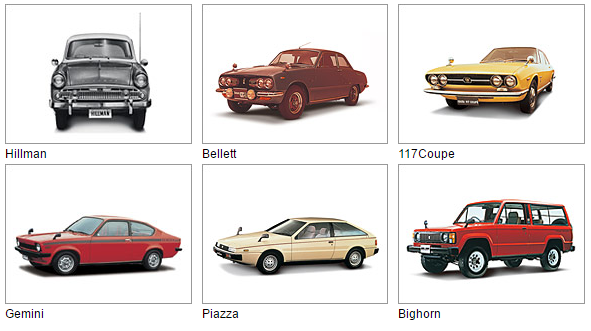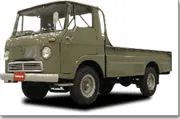Isuzu History

Isuzu traces its beginnings to 1916, the year Tokyo Ishikawajima Shipbuilding and Engineering Co., and Tokyo Gas and Electric Industrial Co. initiated plans for automobile production. In 1922, Japan’s first domestically produced automobile, a Wolseley model A-9 is completed. In 1934, a Ministry of Trade and Industry standard model car was launched and named the “Isuzu”. After World War II, development and production of commercial vehicles occurred at a feverish pace in Japan. There was great demand for Isuzu trucks to carry all kinds of materials, products and foodstuffs, and they played a major role in postwar reconstruction. Since that time, an endless variety of models from light-duty trucks to heavy-duty trucks and buses have rolled off Isuzu production lines
The name “Isuzu” appeared in the first trademark of 1934, when the current Isuzu’s predecessor started mass producing vehicles that met government standards. The name comes from the Isuzu River near Japan’s oldest shrine, the Ise Shrine of Mie prefecture. The name “Isuzu Motors Limited” was adopted in 1949.
The First Passenger Car Produced in Japan
Isuzu’s history can be traced back to its earliest antecedent company, Tokyo Ishikawajima Shipbuilding & Engineering Co., Ltd., which was established in 1893. In 1916, this company diversified into car making, using capital amassed from its highly profitable shipbuilding business (Isuzu’s foundation year) and in 1918, started a passenger vehicle production venture in a tie-up with the British automaker Wolseley Motor Ltd. In 1922, Tokyo Ishikawajima Shipbuilding & Engineering succeeded in localizing production of the Wolseley A9 – the first passenger car ever made in Japan. This achievement was followed in 1924 by the completion of the first Japanese-built Wolseley CP 1.5-ton payload truck qualified as an official military truck by the Japanese government.
In 1927, Tokyo Ishikawajima Shipbuilding & Engineering ended its tie-up with Wolseley and began manufacturing the 100% localized vehicles of its own design. An early example was the “Sumida”, developed in 1929, which was equipped with an A6 or an A4 engine and realized excellent power and fuel consumption.

History of passenger vehicles
Isuzu was also an automotive engineering pioneer as a passenger vehicle manufacturer. Starting with the first Hillman passenger car in 1953, Isuzu introduced Bellel in 1961 and Bellett in 1963. The Bellett GT, affectionately called by the nickname, Bele-G, gained great popularity. In 1968, the Giugiaro-designed 117-Coupe reached the market. The Gemini, a vehicle jointly developed with GM, was introduced in 1974, followed in 1981 by another Giugiaro-design, the Piazza, and a compact 4WD vehicle, the Rodeo Bighorn. In 1985, Isuzu introduced FF Gemini, and its television commercial featuring daredevil stunt-driving was a great hit. Isuzu’s distinctive passenger cars and sport-utility vehicles still have a loyal following of fans even now.
Isuzu inaugurated its overseas operations in 1949 with the first export of its first vehicles to Hong Kong. In 1971, the affiliation agreement with General Motors marked the beginning of Isuzu’s full-scale overseas strategy, and by 1972 the company was exporting KB pickup trucks to the United States. In another partnership with GM, Isuzu unveiled the Gemini in 1974, which was developed under the first “world car” plan. Since then, Isuzu has been expanding its overseas subsidiaries and opened manufacturing plants or sales bases in Thailand in 1974, in North America in 1975, and in China in 1985. In China, today’s operations are rooted in friendships developed through Isuzu’s pioneering technology transfers and establishment of joint ventures. Diesel engine plants began production in Poland in 1999 and in the United States in 2000. Cumulative production of diesel engines in Japan and abroad already exceeds 20 million units.
Between 2005 and 2007, sales bases were established in Spain, Mexico, Canada and South Africa, and local manufacturing began in India and Uzbekistan. Moreover, we established a joint venture in Russia for truck manufacturing and sales.
The Origin of Isuzu Vehicle
In the same year that the “Sumida” appeared, the Car Department was split off from Tokyo Ishikawajima Shipbuilding & Engineering and established as an independent company named Ishikawa Automotive Works Co., Ltd. The late 1920s was a period when car ownership was beginning to expand in the aftermath of the 1923 Great Kanto Earthquake, as automobiles were demonstrating their potential to speed the pace of recovery following the disaster. In view of the growing demand for motor vehicles, the Japanese Government promoted domestic automobile industry. In 1933, Ishikawa Automotive Works responded by launching the “Isuzu”, a government standard model car named after the Isuzu River that flows past the Japan’s oldest shrine, the Ise Shrine of Mie prefecture. The company’s present name was later taken from that of the car.
The Establishment of Isuzu Motors
On April 9, 1937, Automobile Industries merged with Tokyo Gas & Electric Co. to establish Tokyo Automobile Industries Co., Ltd. Isuzu regards this date as the foundation day of the present Isuzu Motors Ltd. In 1941, Tokyo Automobile Industries obtained authorization as an exclusively approved company for diesel vehicle production and changed its name to Diesel Automobile Industry Co., Ltd. The company then played the core role in the development of diesel engines in Japan. After the end of the World War II, the water-cooled DA engine series developed during the war years were equipped in TX80 and other trucks for civil use in the postwar reconstruction effort. As a result of the widespread use of these vehicles, Isuzu became solidified in the public mind as a top diesel engine manufacturer in Japan.

The Isuzu ELF-A Light-Duty Truck
In 1949, Diesel Automobile Industry underwent a final name change to become Isuzu Motors Ltd., the company’s present name. Soon afterwards, the domestic demand for commercial vehicles expanded rapidly due to a rush of emergency orders prompted by the Korean War. Isuzu was in an ideal position to take advantage of this special demand and develop improved products, on account of which the company’s sales of diesel-powered vehicles shot up.
Then, in 1959, Isuzu launched the ELF, which holds the number-one share in the domestic light duty truck market today. Employing an original, easy-to-use cab-over style, the ELF immediately became the country’s best-selling light-duty truck, a position it has continued to command ever since.
Origins of Isuzu Diesel
After the German engineer Rudolf Diesel developed the world’s first diesel engine in 1893, decades passed until the birth of Japan’s first practical automotive diesel engine.
While Japan’s first diesel engine was developed by the Navy in 1907, the model was not for practical use but for research use. However, many private companies continued their efforts to develop diesel engines for various industries including the automobile industry.
Automobile Industries Co., Ltd., an Isuzu predecessor, established a diesel research committee in 1934, as part of the operational policies of then President Tomonosuke Kano. Just two years later in 1936, the company manufactured Japan’s first air-cooled diesel engine, which marked a breakthrough in the history of diesel engine development.
This engine model surpassed competitors when vehicles for both civilian and military use equipped with it soon.
Automobile Industries was merged with two other companies into Tokyo Automobile Industries Co., Ltd. in 1937.
The Japanese government designated Tokyo Automobile Industries in 1941 as the only company that was permitted to manufacture diesel-powered vehicles. Thus, the company, which was renamed Isuzu Motors Limited in 1949, has established strong foothold in the industry to lead the diesel engine technology.
Postwar Era
In response to the fast growing demand after the World War II for restoring vehicle production, Isuzu Motors developed the DA80 diesel-Japan’s first V8 engine-in 1950.
In addition, Isuzu developed a pre-combustion chamber, which had been improved through wartime to the postwar era as the industry’s standard indirect-injection combustion chamber.
Isuzu also developed a direct-injection combustion chamber in which an advanced configuration was incorporated. The model attracted the industry’s attention for its high performance.
1955-1964
Japan still suffered a shortage of fuel early in the decade. However, the launch of Isuzu’s bonnet-type truck in 1959 led to explosive sales. With the excellent fuel economy of its DA640 diesel, it boasted rugged performance on bumpy roads and extra durability even if the truck was heavily over-loaded.
Isuzu developed Japan’s first diesel engine for passenger cars in 1961. The DL201 model was presented with the 1961 Technological Award by the Japan Society of Mechanical Engineers.
The DL200 model, which was mounted in 1964 on the Elf, Japan’s first cab-over light-duty truck, has gained great popularity in the market thanks to its excellence in economy and durability.
1965-1974
Japan entered the age of high-speed transportation in the decade by enhancing transportation infrastructure, backed by a fast growing economy. In the latter half of the period, the U.S. dollar crisis in 1971 and the first oil crisis in 1973 forced automakers to pay attention to energy-saving vehicles, competing with each other in developing turbo-charged engines and intercooled engines. Air pollution and noise also became critical issues for the automobile industry.
To cope with the trend, Isuzu adopted in 1973 its newly-developed low-emission, light-weight and high output PA model in the V Series lineup to ten-ton payload trucks and tractors.
1975-1984
The second oil crisis in 1979 resulted in further implementation of energy-saving measures among industries in Japan. This helped recovery of Japan’s sluggish economy. The automobile industry saw an increasing customers’ need for vehicles which featured, in addition to enhanced safety, low pollution, high output and good fuel economy.
In response to this need, Isuzu put on sale in 1981 ten-ton payload trucks equipped with high-torque, fuel-saving turbo-charged 8PB1-T and 6RA1-T engines. In 1983, the company released a new heavy-duty truck series in Japan, named as the 810 Series, after carrying out the first full-scale changes in 15 years. Improved features of the new series included the introduction of advanced diesels such as electronically controlled 6RA1-TC turbo-charged model, which incorporated intercooled design, and the V-type PC Series engines, which boasted enhanced displacement.
In small diesels, Isuzu promoted the use of fuel-efficient diesels in passenger cars through the release of the diesel-powered Florian and Gemini in 1977 and 1979, respectively.
Isuzu led the industry in the field of direct-injection diesel engines for light-duty trucks. In 1981, the company introduced direct-injection design, which features both high output and low fuel consumption, to all diesels mounted on two-ton payload trucks. In addition, It was Isuzu that developed world’s first full-scale electronically controlled diesel for both light- and heavy-duty trucks.
Isuzu also led the industry in developing ceramics for diesels. Isuzu developed the Ultra Quick on Start (QOS) system in 1981, which eliminated preheating time during start-up for the first time in the world. The system, which incorporated a newly-developed ceramic glow plug with high heat-resistance and electronic control, became indispensable for diesels, especially in passenger cars.

You must be logged in to post a comment.